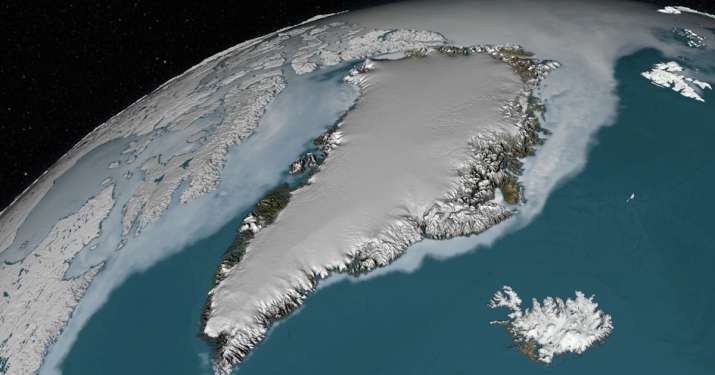Greenland's Ice Conceals A U.S. Nuclear Base: History And Implications

Table of Contents
The Cold War Origins of Camp Century: A Frozen Secret
Project Iceworm: The Concealed Military Objective
Camp Century's official cover story masked its true purpose: Project Iceworm. This ambitious undertaking envisioned a network of underground missile bases, strategically positioned within the Greenland ice sheet to launch nuclear attacks against the Soviet Union. The project was conceived during the height of the Cold War, a period characterized by intense geopolitical rivalry and the ever-present threat of nuclear war.
- Strategic Location: Greenland's proximity to the Soviet Union, its vast, uninhabited icy expanse, and its relative inaccessibility made it an ideal location for a hidden military installation. The Arctic's strategic importance was paramount during the Cold War.
- Technological Challenges: Constructing a base within the Greenland ice sheet presented significant technological hurdles. The project required innovative engineering solutions to overcome the challenges of building and maintaining structures in such an extreme environment. The moving ice itself presented a significant engineering problem.
- Secrecy and Implications: The extreme secrecy surrounding Project Iceworm highlights the Cold War's clandestine operations and the lengths to which superpowers went to gain a military advantage. The project's concealment underscores the geopolitical tensions of the era.
Construction and Operations: Life in a Subglacial Base
Life at Camp Century was challenging. Personnel lived and worked in a self-contained, underground city, facing extreme isolation and logistical difficulties.
- Living Conditions and Logistical Hurdles: Supplies and personnel had to be transported across vast distances and often in treacherous conditions. Living conditions were cramped, and the constant threat of equipment malfunction added to the stress.
- Concurrent Scientific Research: Ironically, alongside its military objective, Camp Century also conducted scientific research on the Greenland ice sheet. This research, though seemingly unrelated to the project's main goal, contributed to our understanding of the Arctic environment.
- Abandonment of Project Iceworm: Despite significant investment and effort, Project Iceworm was ultimately abandoned due to the inherent instability of the ice sheet. The ice's movement made the long-term viability of the underground bases impossible.
The Legacy of Camp Century: Unresolved Environmental Concerns
The Nuclear Waste Problem: A Ticking Time Bomb
The abandonment of Camp Century left behind a significant environmental hazard: radioactive waste. The buried waste poses a significant threat to the environment.
- Types and Quantities of Radioactive Waste: The waste includes low-level radioactive materials from the base's operations, posing a long-term environmental threat. Precise quantities are still debated.
- Potential for Meltwater Contamination: The melting Greenland ice sheet poses a severe risk. As the ice melts, the radioactive waste could contaminate nearby waterways and ecosystems, potentially spreading contamination far beyond the immediate area. This is a major environmental concern.
- Challenges of Retrieving the Waste: Removing the buried waste presents significant logistical and technological challenges. The remote location and the unstable nature of the ice sheet make any remediation efforts complex and expensive.
Climate Change and the Melting Ice: Exposing the Secret
Climate change is dramatically accelerating the melting of the Greenland ice sheet, threatening to expose the buried waste at Camp Century.
- Current Rate of Ice Melt in Greenland: The Greenland ice sheet is melting at an alarming rate, directly influenced by global warming. This melting poses a direct threat to the integrity of the containment area for the waste at Camp Century.
- Potential Consequences of Waste Exposure: Exposure of the radioactive waste could have severe environmental and health consequences, both locally and potentially globally. The consequences are far-reaching and require urgent attention.
- Urgency of Addressing This Environmental Issue: The urgency of addressing the radioactive waste at Camp Century cannot be overstated. International cooperation is vital to mitigate the potential environmental disaster.
Geopolitical Implications in the 21st Century: A Renewed Focus on the Arctic
The Arctic's Strategic Importance: A New Cold War?
The Arctic region is experiencing renewed geopolitical interest due to climate change, resource competition, and increased military activity.
- Potential for Future Conflicts Over Arctic Resources: Melting ice is opening up new shipping routes and access to resources, potentially leading to increased competition and conflict between nations.
- Role of Climate Change in Shaping the Arctic Landscape: Climate change is dramatically altering the Arctic landscape, opening new areas for resource extraction and navigation, but also creating significant environmental challenges.
- Increased Military Activity in the Arctic: Several nations are increasing their military presence in the Arctic, reflecting the region's growing strategic importance.
International Cooperation and Environmental Responsibility
Addressing the legacy of Camp Century requires international cooperation and a commitment to environmental responsibility.
- Possible Solutions for Retrieving the Nuclear Waste: Developing innovative and safe methods for retrieving and disposing of the waste is paramount. International collaboration is essential for finding effective solutions.
- Importance of Environmental Monitoring: Continuous monitoring of the Camp Century site is crucial to assess the environmental impact of the melting ice and to detect any potential contamination.
- Need for Transparent and Collaborative Efforts: Open communication and collaboration between nations are vital to address the environmental and geopolitical challenges posed by Camp Century.
Conclusion
The hidden history of Camp Century, a secret U.S. nuclear base buried beneath Greenland's ice, reveals a complex interplay of Cold War geopolitics, technological ambition, and unforeseen environmental consequences. Climate change is now exacerbating the situation, bringing the legacy of this abandoned base into sharp focus. The potential environmental risks and the renewed geopolitical interest in the Arctic necessitate urgent action. International cooperation is crucial to address the challenges posed by Camp Century's radioactive waste and to ensure the responsible management of the Arctic region. Discover more about the hidden history of Greenland's ice and the implications of the abandoned US nuclear base, and learn how you can contribute to finding solutions to this complex problem.

Featured Posts
-
 Hamer Bruins En Npo Toezichthouder Moeten Over Leeflang Praten
May 15, 2025
Hamer Bruins En Npo Toezichthouder Moeten Over Leeflang Praten
May 15, 2025 -
 Dodgers Muncy Breaks Silence Amidst Arenado Trade Chatter
May 15, 2025
Dodgers Muncy Breaks Silence Amidst Arenado Trade Chatter
May 15, 2025 -
 San Diego Padres Vs New York Yankees A Deep Dive Into The Series Prediction
May 15, 2025
San Diego Padres Vs New York Yankees A Deep Dive Into The Series Prediction
May 15, 2025 -
 Jaylen Brown Names Le Brons Unsurpassed Area A Comparison With Michael Jordan
May 15, 2025
Jaylen Brown Names Le Brons Unsurpassed Area A Comparison With Michael Jordan
May 15, 2025 -
 Ledra Pal Da Carsamba Dijital Veri Tabani Ve Isguecue Piyasasi Rehberi
May 15, 2025
Ledra Pal Da Carsamba Dijital Veri Tabani Ve Isguecue Piyasasi Rehberi
May 15, 2025
